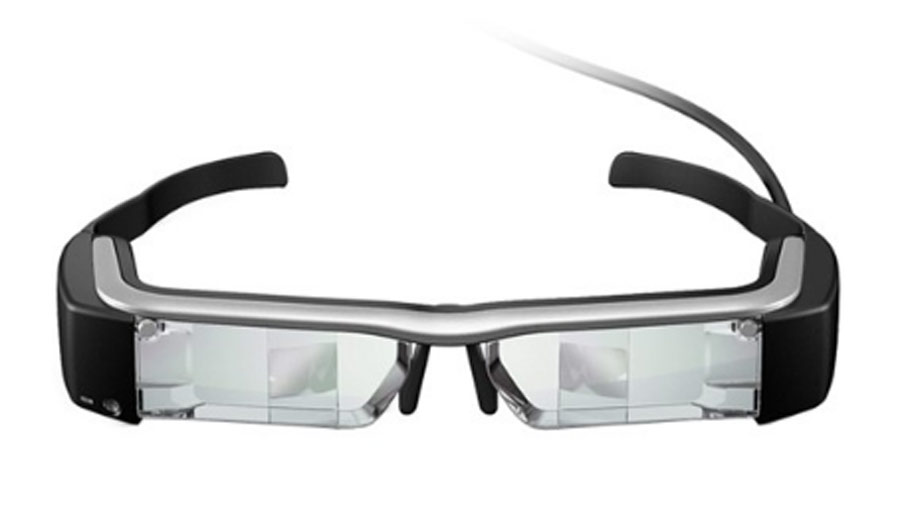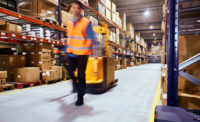Companies are increasingly experimenting with smartglasses in the warehouse. Powered by their own processor and battery, these wearable high-tech eyeglasses collect data from a building's wireless network, then project text and numbers onto a tiny screen incorporated into the glasses.
From a user's perspective, the display looks like full-sized text, overlaid on top of whatever "real world" scene the wearer is viewing at the time. The idea is to give workers hands-free access to computer-generated info, eliminating the need to carry handheld scanners or written documents—like pick lists, manuals, or printed instructions—with them, thereby boosting productivity.
Smartglass technology can enable "vision picking" by projecting visual cues and directions for order fulfillment tasks into a wearer's field of view. The technology can support various warehouse applications from training programs to forklift navigation, helping build a case for adding smartglasses to the supply chain.
Among the early adopters is DHL Supply Chain, the supply chain services division of the giant international parcel carrier and logistics specialist. After the success of an initial smartglass trial in 2014, the company announced in August 2016 that it was rolling out a second phase of the project. Phase two will include pilot programs in facilities in the U.S., the Netherlands, and the U.K.
By providing its warehouse workers with an augmented reality (AR) view—a live view of the physical environment supplemented by computer-generated input—of their surroundings, the company can give individual workers visual instructions on where each picked item needs to be placed on a trolley, DHL says. This vision picking approach enables hands-free order picking that is faster and more accurate than other methods, and also generates a digital record of the traditionally manual process of moving items around the shop floor, according to the German company.
Material handling operations see a bright future for wearables and mobile technology, with 75 percent of the industry looking to adopt this technology in the warehouse within six to 10 years, according to the 2016 MHI Annual Industry Report, "Accelerating change: How innovation is driving digital, always-on supply chains."
The survey showed, however, that current rates of adoption lag far behind that at just 26 percent. Produced by MHI and Deloitte Consulting, the study was based on responses from nearly 900 manufacturers, distributors, service providers, and other industry players.
The survey found that with emerging technologies in general—a class that includes robotics, sensors, drones, cloud computing, and 3-D printing as well as smartglasses—the major barrier to investment is the lack of a clear business case to justify the cost (43 percent of respondents). That was followed by the lack of talent to utilize new technology effectively (38 percent) and a cultural aversion to risk (35 percent).
For smartglass wearables in particular, barriers to adoption include the need for smaller, more powerful batteries; the high price of smartglass hardware in comparison with tablets and smartphones; and the difficulties of software integration with back-end platforms like customer relationship management (CRM), inventory management, point of sale (POS), accounting, or enterprise resource planning (ERP) systems, the MHI study found.
To date, smartglass technology is producing the best results in warehouse picking applications, where mistakes tend to be very expensive. Prime candidates for smartglass use include operations that handle a low volume of high-value parts and high-throughput third-party e-commerce fulfillment operations.
Other applications in which smartglass technology has delivered a swift ROI include training seasonal DC workers and streamlining maintenance operations, Kim said.
What makes logistics and warehousing particularly suitable for AR?
A warehouse is busy but well planned out. You can outfit employees with AR to improve their efficiency and reduce errors. You can eliminate paper requirements, error check, make sure they're picking the right packages, and do it all autonomously in the headset.
Before the glasses really take off, a few bugs remain to be worked out. Even the top platforms have some basic constraints with respect to battery life and comfort that restrict them from being used for full work shifts.
Because of ergonomic considerations like weight, battery life, and overheating, early models were never intended to be worn for a full eight-hour warehouse shift. Now, a second generation of smartglass products has made strides addressing those problems.
Among other improvements, second-generation smartglasses now come with features like a microphone and audio link, an embedded digital camera, geolocating capability, and the ability to display real-time text messages in a user's AR view. Companies can leverage those features to expand the devices' use far beyond basic picking applications. Warehouse-related uses for second-generation smartglasses could include:
- Managing exceptions. If a warehouse picker is directed to a rack location but finds it empty, he or she can now share his screen with a back-office supervisor. That supervisor can then link to the smartglass video display, see exactly what the employee is looking at, and change the pick order accordingly, without ever having to leave his or her office.
- Training workers. That same "telemonitoring" ability could allow managers to view exactly what each employee is seeing at any given time. The ability to share a view could enable managers to act like a coach perched on the user's shoulder, although workers might have privacy concerns.
- Remote maintenance. If a high-speed shoe sorter breaks down, a maintenance worker could launch a video conference with a remote expert, who could see the problem in real time, then use AR annotation to type instructions that appear in the worker's field of view and help him or her identify the broken part.
- Inventory putaway. In putaway applications, smartglass technology could be used to provide a forklift driver with a view of the warehouse with driving directions overlaid on the actual aisles and racks in front of him or her.
While these applications are already technically possible, engineers remain hard at work refining both smartglass hardware and software. In addition to the need to extend battery life as mentioned earlier, improvements are still needed to address heat buildup in processor chips, integrate smartglass platforms with warehouse management systems and other software, offer translucent data overlays instead of displays that can occlude a wearer's field of vision, and improve the size and style of smartglasses to make them more appealing to users.
Source: www.dcvelocity.com




